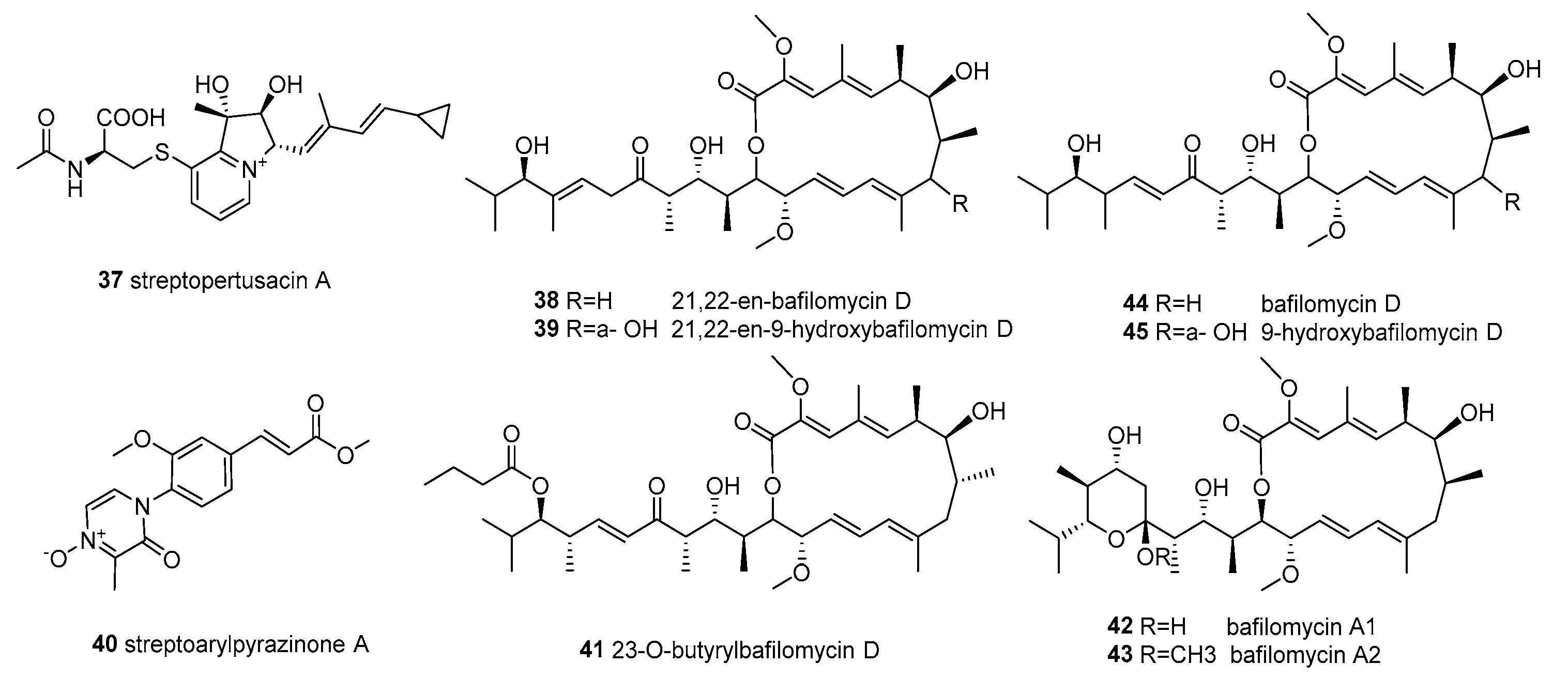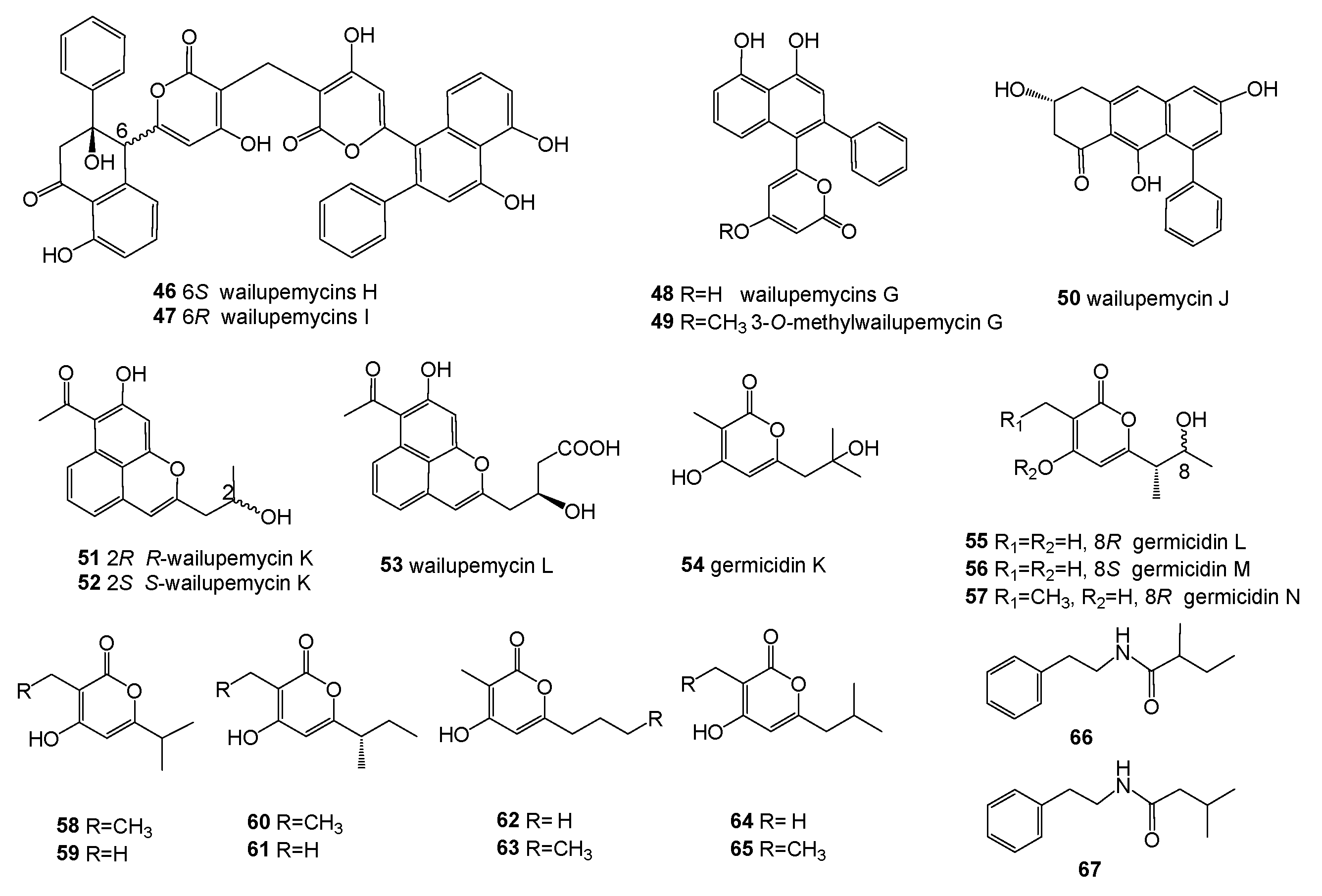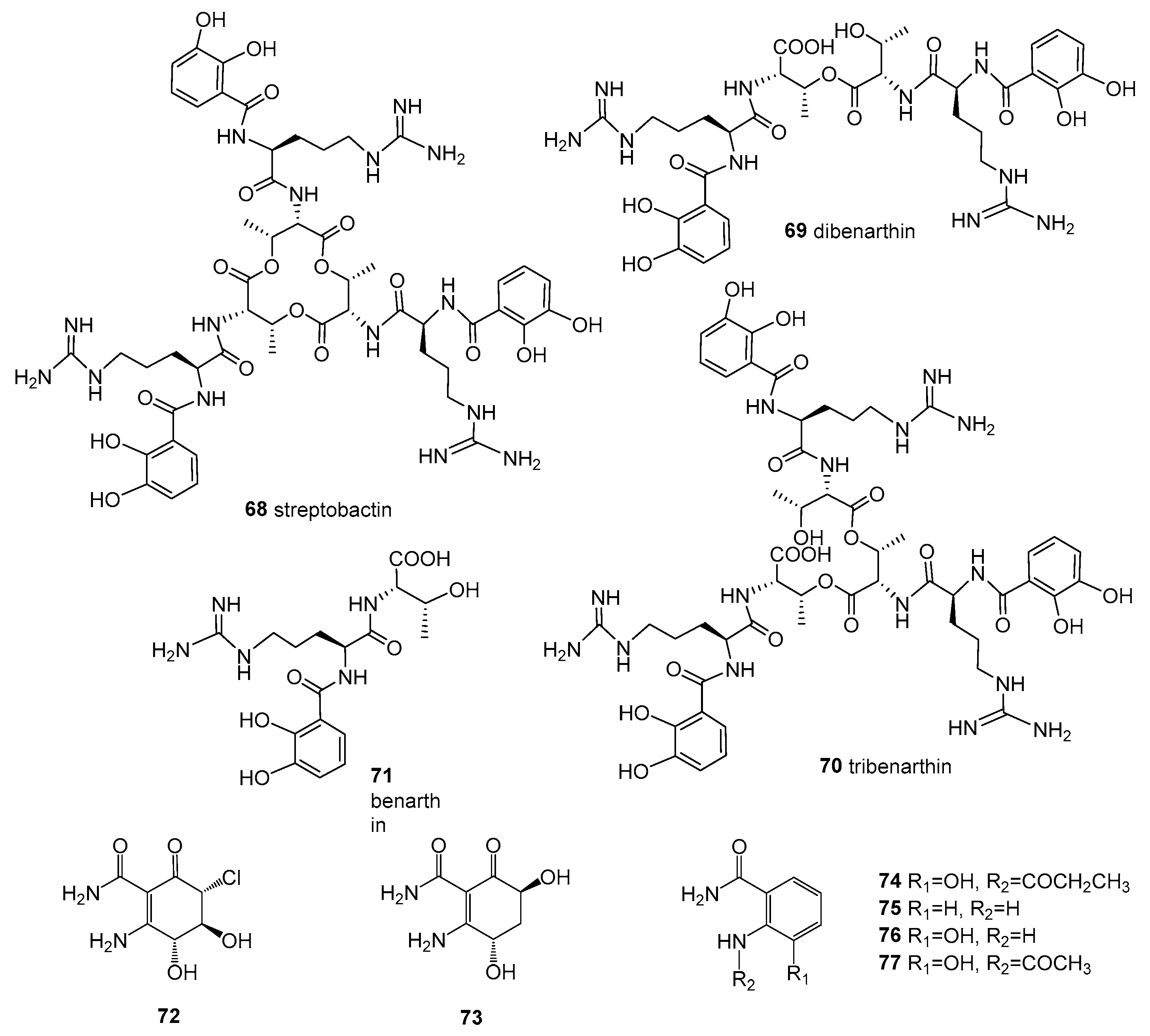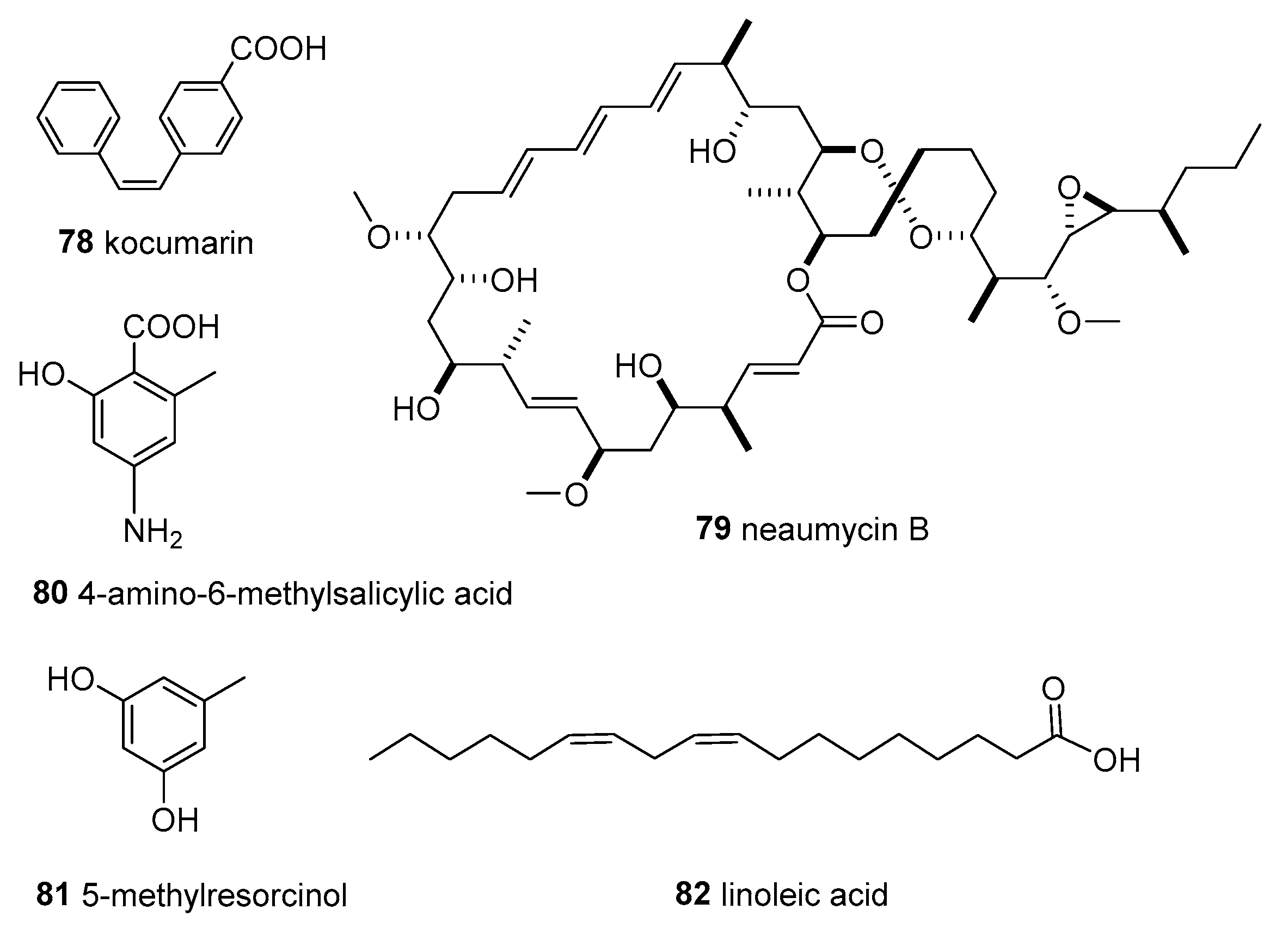Natural Products and Biological Activity from Actinomycetes Associated with Marine Algae
Abstract
:1. Introduction
2. Marine Actinomyces
3. Actinomycetes Isolation from Marine Algae and Preliminary Identification
4. Abundance of Actinomycetes Associated with Marine Algae
5. Biological Activities of the Actinomycetes Associated with Marine Algae
6. Bioactive Metabolites from Actinomycetes Associated with Marine Algae
6.1. Bioactive Metabolites from Streptomyces
6.2. Bioactive Metabolites from Non-Streptomyces
7. Conclusions
Author Contributions
Funding
Institutional Review Board Statement
Informed Consent Statement
Data Availability Statement
Conflicts of Interest
Sample Availability
References
- Newman, D.J.; Cragg, G.M. Natural products as sources of new drugs over the nearly four decades from 01/1981 to 09/2019. J. Nat. Prod. 2020, 83, 770–803. [Google Scholar] [CrossRef] [PubMed] [Green Version]
- Banerjee, P.; Mandhare, A.; Bagalkote, V. Marine natural products as source of new drugs: An updated patent review (July 2018–July 2021). Expert Opin. Ther. Pat. 2022, 32, 317–363. [Google Scholar] [CrossRef] [PubMed]
- Poli, A.; Finore, I.; Romano, I.; Gioiello, A.; Lama, L.; Nicolaus, B. Microbial diversity in extreme marine habitats and their biomolecules. Microorganisms 2017, 5, 25. [Google Scholar] [CrossRef] [PubMed] [Green Version]
- Hai, Y.; Wei, M.Y.; Wang, C.Y.; Gu, Y.C.; Shao, C.L. The intriguing chemistry and biology of sulfur-containing natural products from marine microorganisms (1987–2020). Mar. Life Sci. Technol. 2021, 3, 488–518. [Google Scholar] [CrossRef]
- Sharma, S.; Rani, V.; Saini, R.; Verma, M.L. Bioprospecting and biotechnological applications of microbial endophytes. In Microbial Technology for Health and Environment; Arora, P., Ed.; Springer: Singapore, 2020; Volume 22, pp. 191–228. [Google Scholar]
- Strobel, G.; Daisy, B. Bioprospecting for microbial endophytes and their natural products. Microbiol. Mol. Biol. Rev. 2003, 67, 491–502. [Google Scholar] [CrossRef] [Green Version]
- Rengasamy, K.R.; Mahomoodally, M.F.; Aumeeruddy, M.Z.; Zengin, G.; Xiao, J.; Kim, D.H. Bioactive compounds in seaweeds: An overview of their biological properties and safety. Food Chem. Toxicol. 2020, 135, 111013. [Google Scholar] [CrossRef]
- Strobel, G.; Daisy, B.; Castillo, U.; Harper, J. Natural products from endophytic microorganisms. J. Nat. Prod. 2004, 67, 257–268. [Google Scholar] [CrossRef]
- Zhang, P.; Li, X.; Wang, B.G. Secondary metabolites from the marine algal-derived endophytic fungi: Chemical diversity and biological activity. Planta Med. 2016, 82, 832–842. [Google Scholar] [CrossRef] [Green Version]
- Egan, S.; Thomas, T.; Kjelleberg, S. Unlocking the diversity and biotechnological potential of marine surface associated microbial communities. Curr. Opin. Microbiol. 2008, 11, 219–225. [Google Scholar] [CrossRef]
- Lu, D. Phycosphere microbial diversity and functional potential of four wild macroaglae in the castal of Weihai. Doctoral Dissertation, Shandong Unversity, Jinan, China, 2022. [Google Scholar]
- Carroll, A.R.; Copp, B.R.; Davis, R.A.; Keyzers, R.A.; Prinsep, M.R. Marine natural products. Nat. Prod. Rep. 2023, 40, 275–325. [Google Scholar] [CrossRef]
- Singh, V.K.; Dwivedy, A.K.; Singh, A.; Asawa, S.; Dwivedi, A.; Dubey, N.K. Fungal endophytes from seaweeds: An overview. In Microbial Biotechnology; Patra, J., Das, G., Shin, H.S., Eds.; Springer: Singapore, 2018; Volume 2, pp. 483–498. [Google Scholar]
- Sun, X. Diversity and polyphasic taxonomy of epiphytic bacteria isolated from macroalgae. Master’s Dissertation, Shandong Normal Unversity, Jinan, China, 2021. [Google Scholar]
- Wiese, J.; Thiel, V.; Nagel, K.; Staufenberger, T.; Imhoff, J.F. Diversity of antibiotic-active bacteria associated with the brown alga Laminaria saccharina from the Baltic Sea. Mar. Biotechnol. 2009, 11, 287–300. [Google Scholar] [CrossRef] [Green Version]
- Jagannathan, S.V.; Manemann, E.M.; Rowe, S.E.; Callender, M.C.; Soto, W. Marine actinomycetes, new sources of biotechnological products. Mar. Drugs 2021, 19, 365. [Google Scholar] [CrossRef] [PubMed]
- Sarkar, G.; Suthindhiran, K. Diversity and biotechnological potential of marine actinomycetes from India. Indian J. Microbiol. 2022, 62, 475–493. [Google Scholar] [CrossRef] [PubMed]
- Jose, P.A.; Maharshi, A.; Jha, B. Actinobacteria in natural products research: Progress and prospects. Microbiol. Res. 2021, 246, 126708. [Google Scholar] [CrossRef] [PubMed]
- Jiang, J.; Sun, Y.F.; Tang, X.; He, C.N.; Shao, Y.L.; Tang, Y.J.; Zhou, W.W. Alkaline pH shock enhanced production of validamycin A in fermentation of Streptomyces hygroscopicus. Bioresour. Technol. 2018, 249, 234–240. [Google Scholar] [CrossRef] [PubMed]
- Okami, Y. Marine microorganisms as a source of bioactive agents. Microb. Ecol. 1986, 12, 65–78. [Google Scholar] [CrossRef] [PubMed]
- Siro, G.; Pipite, A.; Christi, K.; Srinivasan, S.; Subramani, R. Marine actinomycetes associated with stony corals: A potential hotspot for specialized metabolites. Microorganisms 2022, 10, 1349. [Google Scholar] [CrossRef]
- Valliappan, K.; Sun, W.; Li, Z. Marine actinobacteria associated with marine organisms and their potentials in producing pharmaceutical natural products. Appl. Microbiol. Biotechnol. 2014, 98, 7365–7377. [Google Scholar] [CrossRef]
- Chen, J.; Xu, L.; Zhou, Y.; Han, B. Natural products from actinomycetes associated with marine organisms. Mar. Drugs 2021, 19, 629. [Google Scholar] [CrossRef]
- Noorjahan, A.; Mahesh, S.; Anantharaman, P.; Aiyamperumal, B. Antimicrobial potential of seaweeds: Critical review. In Microbial Biotechnology; Patra, J., Das, G., Shin, H.S., Eds.; Springer: Singapore, 2022; Volume 1, pp. 399–420. [Google Scholar]
- Costa, M.; Cardoso, C.; Afonso, C.; Bandarra, N.M.; Prates, J.A. Current knowledge and future perspectives of the use of seaweeds for livestock production and meat quality: A systematic review. J. Anim. Physiol. Anim. Nutr. 2021, 105, 1075–1102. [Google Scholar] [CrossRef]
- Lachnit, T.; Meske, D.; Wahl, M.; Harder, T.; Schmitz, R. Epibacterial community patterns on marine macroalgae are host-specific but temporally variable. Environ. Microbiol. 2011, 13, 655–665. [Google Scholar] [CrossRef] [PubMed]
- Ihua, M.W.; FitzGerald, J.A.; Guihéneuf, F.; Jackson, S.A.; Claesson, M.J.; Stengel, D.B.; Dobson, A.D. Diversity of bacteria populations associated with different thallus regions of the brown alga Laminaria digitata. PLoS ONE 2020, 15, e0242675. [Google Scholar] [CrossRef] [PubMed]
- Yu, W.; Tang, X.; Xiong, Z.; Zhang, S.; Wang, R.; Zeng, X.; Guo, Z. Isolation and antimicrobial bioactivity of algae associated actinomycetes from Xisha Islands. Acta Microbiol. Sin. 2023, 63, 1472–1489. [Google Scholar]
- Girão, M.; Ribeiro, I.; Ribeiro, T.; Azevedo, I.C.; Pereira, F.; Urbatzka, R.; Leão, P.N.; Carvalho, M.F. Actinobacteria isolated from Laminaria ochroleuca: A source of new bioactive compounds. Front. Microbiol. 2019, 10, 683. [Google Scholar] [CrossRef] [Green Version]
- Leiva, S.; Alvarado, P.; Huang, Y.; Wang, J.; Garrido, I. Diversity of pigmented Gram-positive bacteria associated with marine macroalgae from Antarctica. FEMS Microbiol. Lett. 2015, 362, 24. [Google Scholar] [CrossRef] [PubMed] [Green Version]
- Rajivgandhi, G.; Ramachandran, G.; Maruthupandy, M.; Vaseeharan, B.; Manoharan, N. Molecular identification and structural characterization of marine endophytic actinomycetes Nocardiopsis sp. GRG 2 (KT 235641) and its antibacterial efficacy against isolated ESBL producing bacteria. Microb. Pathog. 2019, 126, 138–148. [Google Scholar] [CrossRef]
- Axenov-Gribanov, D.V.; Kostka, D.V.; Vasilieva, U.A.; Shatilina, Z.M.; Krasnova, M.E.; Pereliaeva, E.V.; Zolotovskaya, E.D.; Morgunova, M.M.; Rusanovskaya, O.O.; Timofeyev, M.A. Cultivable actinobacteria first found in baikal endemic algae is a new source of natural products with antibiotic activity. Int. J. Microbiol. 2020, 2020, 5359816. [Google Scholar] [CrossRef]
- Kim, M.C.; Machado, H.; Jang, K.H.; Trzoss, L.; Jensen, P.R.; Fenical, W. Integration of genomic data with NMR analysis enables assignment of the full stereostructure of neaumycin B, a potent inhibitor of glioblastoma from a marine-derived Micromonospora. J. Am. Chem. Soc. 2018, 140, 10775–10784. [Google Scholar] [CrossRef] [Green Version]
- Ulfah, M.; Kasanah, N.; Handayani, N.S.N. Bioactivity and genetic screening of marine actinobacteria associated with red algae Gelidiella acerosa. Int. J. Biotech. 2017, 22, 13–21. [Google Scholar] [CrossRef] [Green Version]
- Rajivgandhi, G.; Ramachandran, G.; Maruthupandy, M.; Saravanakumar, S.; Manoharan, N.; Viji, R. Antibacterial effect of endophytic actinomycetes from marine algae against multi drug resistant gram negative bacteria. Exams Mar. Biol. Oceanogr. 2018, 1, 132–138. [Google Scholar]
- Rajivgandhi, G.; Vijayan, R.; Kannan, M.; Santhanakrishnan, M.; Manoharan, N. Molecular characterization and antibacterial effect of endophytic actinomycetes Nocardiopsis sp. GRG1 (KT235640) from brown algae against MDR strains of uropathogens. Bioact. Mater. 2016, 1, 140–150. [Google Scholar] [CrossRef] [Green Version]
- Majithiya, V.R.; Gohel, S.D. Isolation and characterization of marine actinobacteria associated with the seaweeds, Codium dwarkense and Sargassum cinereum, collected from the Veraval coastline, Gujarat, India. J. Mar. Biol. Assoc. India 2022, 64, 34. [Google Scholar] [CrossRef]
- Lee, S.D.; Kim, S.J. Aeromicrobium tamlense sp. nov., isolated from dried seaweed. Int. J. Syst. Evol. Microbiol. 2007, 57, 337–341. [Google Scholar] [CrossRef] [Green Version]
- Wang, J.; Leiva, S.; Huang, J.; Huang, Y. Amycolatopsis antarctica sp. nov., isolated from the surface of an Antarctic brown macroalga. Int. J. Syst. Evol. Microbiol. 2018, 68, 2348–2356. [Google Scholar] [CrossRef]
- Lee, S.D. Agrococcus jejuensis sp. nov., isolated from dried seaweed. Int. J. Syst. Evol. Microbiol. 2008, 58, 2297–2300. [Google Scholar] [CrossRef] [PubMed]
- Lee, S.D. Labedella gwakjiensis gen. nov., sp. nov., a novel actinomycete of the family Microbacteriaceae. Int. J. Syst. Evol. Microbiol. 2007, 57, 2498–2502. [Google Scholar] [CrossRef] [PubMed]
- Lee, D.W.; Lee, J.M.; Seo, J.P.; Schumann, P.; Kim, S.J.; Lee, S.D. Phycicola gilvus gen. nov., sp. nov., an actinobacterium isolated from living seaweed. Int. J. Syst. Evol. Microbiol. 2008, 58, 1318–1323. [Google Scholar] [CrossRef]
- Braña, A.F.; Fiedler, H.P.; Nava, H.; González, V.; Sarmiento-Vizcaíno, A.; Molina, A.; Acuna, J.L.; Garcia, L.A.; Blanco, G. Two Streptomyces species producing antibiotic, antitumor, and anti-inflammatory compounds are widespread among intertidal macroalgae and deep-sea coral reef invertebrates from the central Cantabrian Sea. Microb. Ecol. 2015, 69, 512–524. [Google Scholar] [CrossRef] [PubMed]
- Abdelmohsen, U.R.; Bayer, K.; Hentschel, U. Diversity, abundance and natural products of marine sponge-associated actinomycetes. Nat. Prod. Rep. 2014, 31, 381–399. [Google Scholar] [CrossRef] [PubMed]
- Rajivgandhi, G.N.; Ramachandran, G.; Kanisha, C.C.; Li, J.L.; Yin, L.; Manoharan, N.; Alharbi, N.S.; Kadaikunnan, S.; Khaled, J.M.; Li, W.J. Anti-biofilm compound of 1, 4-diaza-2, 5-dioxo-3-isobutyl bicyclo [4.3.0] nonane from marine Nocardiopsis sp. DMS 2 (MH900226) against biofilm forming K. pneumoniae. J. King Saudi Univ.-Sci. 2020, 32, 3495–3502. [Google Scholar] [CrossRef]
- Anand, J.; Ramamoorthy, K.; Muthukumar, G.; Nagaraj, S. Production and partial purification of α-amylase producing Streptomyces sp. SNAJSM6 isolated from seaweed Sargassum myriocystum. Indian J. Geo Mar. Sci. 2019, 48, 1245–1251. [Google Scholar]
- Rajivgandhi, G.; Vimala, R.T.V.; Maruthupandy, M.; Alharbi, N.S.; Kadaikunnan, S.; Khaled, J.M.; Manoharan, N.; Li, W.J. Enlightening the characteristics of bioflocculant of endophytic actinomycetes from marine algae and its biosorption of heavy metal removal. Environ. Res. 2021, 200, 111708. [Google Scholar] [CrossRef]
- Choi, H.J.; Hong, J.B.; Park, J.J.; Chi, W.J.; Kim, M.C.; Chang, Y.K.; Hong, S.K. Production of agarase from a novel Micrococcus sp. GNUM-08124 strain isolated from the East Sea of Korea. Biotechnol. Bioproc. E 2011, 16, 81–88. [Google Scholar] [CrossRef]
- Javee, A.; Karuppan, R.; Subramani, N. Bioactive glycolipid biosurfactant from seaweed Sargassum myriocystum associated bacteria Streptomyces sp. SNJASM6. Biocatal. Agr. Biotechnol. 2020, 23, 101505. [Google Scholar] [CrossRef]
- Matsuo, Y.; Kanoh, K.; Jang, J.H.; Adachi, K.; Matsuda, S.; Miki, O.; Kato, T.; Shizuri, Y. Streptobactin, a tricatechol-type siderophore from marine-derived Streptomyces sp. YM5-799. J. Nat. Prod. 2011, 74, 2371–2376. [Google Scholar] [CrossRef]
- Katif, C.; Chilczuk, T.; Sabour, B.; Belattmania, Z.; Hilmi, A.; Niedermeyer, T.H.J.; Barakate, M. Isolation and structure elucidation of desferrioxamine B and the new desferrioxamine B2 antibiotics from a brown marine macroalga Carpodesmia Tamariscifolia associated Streptomyces isolate. Biointerface Res. Appl. Chem. 2022, 12, 5647–5662. [Google Scholar]
- Betancur, L.A.; Forero, A.M.; Vinchira-Villarraga, D.M.; Cardenas, J.D.; Romero-Otero, A.; Chagas, F.O.; Pupo, M.T.; Castellanos, L.; Ramos, F.A. NMR-based metabolic profiling to follow the production of anti-phytopathogenic compounds in the culture of the marine strain Streptomyces sp. PNM-9. Microbiol. Res. 2020, 239, 126507. [Google Scholar] [CrossRef]
- Djinni, I.; Defant, A.; Kecha, M.; Mancini, I. Antibacterial polyketides from the marine alga-derived endophitic Streptomyces sundarbansensis: A study on hydroxypyrone tautomerism. Mar. Drugs 2013, 11, 124–135. [Google Scholar] [CrossRef] [Green Version]
- Cho, J.Y. Glycoglycerolipids isolated from marine derived Streptomyces coelescens PK206-15. Biosci. Biotech. Biochem. 2012, 76, 1746–1751. [Google Scholar] [CrossRef] [PubMed] [Green Version]
- Jiang, Z.D.; Jensen, P.R.; Fenical, W. Lobophorins A and B, new antiinflammatory macrolides produced by a tropical marine bacterium. Bioorg. Med. Chem. Lett. 1999, 9, 2003–2006. [Google Scholar] [CrossRef] [PubMed]
- Uzair, B.; Menaa, F.; Khan, B.A.; Mohammad, F.V.; Ahmad, V.U.; Djeribi, R.; Menaa, B. Isolation, purification, structural elucidation and antimicrobial activities of kocumarin, a novel antibiotic isolated from actinobacterium Kocuria marina CMG S2 associated with the brown seaweed Pelvetia canaliculata. Microbiol. Res. 2018, 206, 186–197. [Google Scholar] [CrossRef] [PubMed]
- Eliwa, E.M.; Abdel-Razek, A.S.; Frese, M.; Halawa, A.H.; El-Agrody, A.M.; Bedair, A.H.; Sewald, N.; Shaaban, M. New naturally occurring phenolic derivatives from marine Nocardiopsis sp. AS23C: Structural elucidation and in silico computational studies. Vietnam J. Chem. 2019, 57, 164–174. [Google Scholar] [CrossRef] [Green Version]
- Cho, J.Y.; Kim, M.S. Antibacterial benzaldehydes produced by seaweed-derived Streptomyces atrovirens PK288-21. Fish. Sci. 2012, 78, 1065–1073. [Google Scholar] [CrossRef]
- Cho, J.Y.; Kang, J.Y.; Hong, Y.K.; Baek, H.H.; Shin, H.W.; Kim, M.S. Isolation and structural determination of the antifouling diketopiperazines from marine-derived Streptomyces praecox 291-11. Biosci. Biotech. Biochem. 2012, 76, 1116–1121. [Google Scholar] [CrossRef] [Green Version]
- Hong, Y.K.; Cho, J.Y. Effect of seaweed epibiotic bacterium Streptomyces violaceoruber SCH-09 on marine fouling organisms. Fish. Sci. 2013, 79, 469–475. [Google Scholar] [CrossRef]
- Chen, Z.; Hao, J.; Wang, L.; Wang, Y.; Kong, F.; Zhu, W. New α-glucosidase inhibitors from marine algae-derived Streptomyces sp. OUCMDZ-3434. Sci. Rep. 2016, 6, 20004. [Google Scholar] [CrossRef] [Green Version]
- Liu, H.; Chen, Z.; Zhu, G.; Wang, L.; Du, Y.; Wang, Y.; Zhu, W. Phenolic polyketides from the marine alga-derived Streptomyces sp. OUCMDZ-3434. Tetrahedron 2017, 73, 5451–5455. [Google Scholar] [CrossRef]
- Du, Y.; Sun, J.; Gong, Q.; Wang, Y.; Fu, P.; Zhu, W. New α-pyridones with quorum-sensing inhibitory activity from diversity-enhanced extracts of a Streptomyces sp. derived from marine algae. J. Agric. Food Chem. 2018, 66, 1807–1812. [Google Scholar] [CrossRef]
- Zhang, X.; Shu, C.; Li, Q.; Lian, X.Y.; Zhang, Z. Novel cyclohexene and benzamide derivatives from marine-associated Streptomyces sp. ZZ502. Nat. Prod. Res. 2019, 33, 2151–2159. [Google Scholar] [CrossRef]
- Zhang, X.; Chen, L.; Chai, W.; Lian, X.Y.; Zhang, Z. A unique indolizinium alkaloid streptopertusacin A and bioactive bafilomycins from marine-derived Streptomyces sp. HZP-2216E. Phytochemistry 2017, 144, 119–126. [Google Scholar] [CrossRef]
- Zhang, Z.; Chen, L.; Zhang, X.; Liang, Y.; Anjum, K.; Chen, L.; Lian, X.Y. Bioactive bafilomycins and a new N-Arylpyrazinone derivative from marine-derived Streptomyces sp. HZP-2216E. Planta Med. 2017, 83, 1405–1411. [Google Scholar] [CrossRef] [PubMed] [Green Version]
- Braña, A.F.; Sarmiento-Vizcaíno, A.; Pérez-Victoria, I.; Martín, J.; Otero, L.; Palacios-Gutiérrez, J.J.; Fernández, J.; Mohamedi, Y.; Fontanil, T.; Salmón, M.; et al. Desertomycin G, a new antibiotic with activity against Mycobacterium tuberculosis and human breast tumor cell lines produced by Streptomyces althioticus MSM3, isolated from the Cantabrian Sea Intertidal macroalgae Ulva sp. Mar. Drugs 2019, 17, 114. [Google Scholar] [CrossRef] [Green Version]
- Rab, E.; Kekos, D.; Roussis, V.; Ioannou, E. α-pyrone polyketides from Streptomyces ambofaciens BI0048, an endophytic actinobacterial strain isolated from the red alga Laurencia glandulifera. Mar. Drugs 2017, 15, 389. [Google Scholar] [CrossRef] [Green Version]
- Babczinski, P.; Dorgerloh, M.; Löbberding, A.; Santel, H.J.; Schmidt, R.R.; Schmitt, P.; Wünsche, C. Herbicidal activity and mode of action of vulgamycin. Pestic. Sci. 1991, 33, 439–446. [Google Scholar] [CrossRef]
- Sitachitta, N.; Gadepalli, M.; Davidson, B.S. New α-pyrone-containing metabolites from a marine-derived actinomycete. Tetrahedron 1996, 52, 8073–8080. [Google Scholar] [CrossRef]
- Kawashima, A.; Seto, H.; Kato, M.; Uchida, K.; Otake, N. Preparation of fluorinated antibiotics followed by 19F NMR spectroscopy. I. Fluorinated vulgamycins. J. Antibiot. 1985, 38, 1499–1505. [Google Scholar] [CrossRef] [PubMed]
- Shinde, P.; Banerjee, P.; Mandhare, A. Marine natural products as source of new drugs: A patent review (2015–2018). Expert Opin. Ther. Pat. 2019, 29, 283–309. [Google Scholar] [CrossRef] [PubMed]
- Wang, C.; Mei, X.; Zhu, W. New Natural Products from the Marine-Derived Streptomyces Actinobacteria. Stud. Mar. Sin. 2016, 51, 86–124. [Google Scholar]
- Carroll, A.R.; Copp, B.R.; Davis, R.A.; Keyzers, R.A.; Prinsep, M.R. Marine natural products. Nat. Prod. Rep. 2019, 36, 122–173. [Google Scholar] [CrossRef] [Green Version]
- Carroll, A.R.; Copp, B.R.; Davis, R.A.; Keyzers, R.A.; Prinsep, M.R. Marine natural products. Nat. Prod. Rep. 2020, 37, 175–223. [Google Scholar] [CrossRef]
- Carroll, A.R.; Copp, B.R.; Davis, R.A.; Keyzers, R.A.; Prinsep, M.R. Marine natural products. Nat. Prod. Rep. 2021, 38, 362–413. [Google Scholar] [CrossRef]
- Carroll, A.R.; Copp, B.R.; Davis, R.A.; Keyzers, R.A.; Prinsep, M.R. Marine natural products. Nat. Prod. Rep. 2022, 39, 1122–1171. [Google Scholar] [CrossRef] [PubMed]
- Wang, C.; Lei, F.; Tan, X.; Li, X.; Yang, L.; Zhu, C. New natural products from the marine-derived Nocardiopsis spp. Chin. J. Antibiot. 2019, 44, 763–769. [Google Scholar]
- Feling, R.H.; Buchanan, G.O.; Mincer, T.J.; Kauffman, C.A.; Jensen, P.R.; Fenical, W. Salinosporamide A: A highly cytotoxic proteasome inhibitor from a novel microbial source, a marine bacterium of the new genus Salinospora. Angew. Chem. Int. Ed. 2003, 42, 355–357. [Google Scholar] [CrossRef]
- Wang, K.; Chen, R.; Tian, X. Advances in the marine obligate actinomycete genus Salinispora. Biot. Resour. 2018, 40, 430–442. [Google Scholar]
- Menaa, F.; Wijesinghe, P.A.U.I.; Thiripuranathar, G.; Uzair, B.; Iqbal, H.; Khan, B.A.; Menaa, B. Ecological and industrial implications of dynamic seaweed-associated microbiota interactions. Mar. Drugs 2020, 18, 641. [Google Scholar] [CrossRef] [PubMed]







| Isolation Source | Actinobacterial Genera | References |
|---|---|---|
| Brown algae | Amycolatopsis, Arthrobacter, Isoptericola, Kocuria, Labedella, Leifsonia, Microbacterium, Microbispora, Micrococcus, Micromonospora, Nocardiopsis, Nonomuraea, Rhodococcus, Sanguibacter, Streptomyces. | [15,29,30] |
| Red algae | Brachybacterium, Citricoccus, Micrococcus, Salinibacterium, Streptomyces. | [15] |
| Green algae | Agrococcus, Arthrobacter, Brachybacterium, Micromonospora, Nocardiopsis, Rhodococcus, Salinibacterium, Salinispora, Streptomyces. | [15,28] |
| Other algae | Aeromicrobium, Agrococcus, Amycolatopsis, Labedella, Micromonospora, Nonomuraea, Phycicola, Rhodococcus, Salinispora, Streptomyces. | [28,39,40,41,42] |
| Host | Location | Isolates | Biological Activity | References |
|---|---|---|---|---|
| Brown algae | ||||
| Analipus japonicus (Harvey) Wynne | Hokkaido, Japan | Streptomyces sp. YM5-799 | Fe-chelating activity | [50] |
| Carpodesmia tamariscifolia | Atlantic coast of Morocco | Streptomyces albidoflavus KC180 | anti-bacterial activity | [51] |
| Cystoseira baccata | Cantabrian Sea | Streptomyces cyaneofuscatus M-27 | anti-bacterial activity; anti-fungal activity | [43] |
| Streptomyces carnosus M-40 | anti-bacterial activity; anti-fungal activity; anti-inflammatory; antituberculosis | |||
| Dictyota sp. | Colombian Caribbean Sea | Streptomyces sp. PNM-9 | anti-bacterial activity | [52] |
| Fucus sp. | Bejaia coastline, Algeria | Streptomyces sundarbansensis WR1L1S8 | anti-bacterial activity | [53] |
| Laminaria japonica | Coast of Korea | Streptomyces coelescens PK206-15 | antifouling activity | [54] |
| Lobophora variegate | Caribbean | unidentified actinomycete CNC-837 | anti-inflammatory activity | [55] |
| Pelvetia canaliculata | Sonmiani Beach, Karachi, Pakistan | Kocuria marina CMG S2 | anti-bacterial activity; anti-fungal activity | [56] |
| Sargassum arnaudianum | Red Sea at Hurghada coast, Egypt | Nocardiopsis sp. AS23C | anti-bacterial activity | [57] |
| Sargassum myriocystum | Tamil Nadu, Rameshwaram, India | Streptomyces sp. SNJASM6 | anti-bacterial activity; α-amylase; emulsification activities with tween 20, coconut oil, and xylene | [46,49] |
| Stypopodium zonale | Bahamas Islands | Micromonospora sp. CNY-010 | cytotoxicity | [33] |
| Turbinaria ornata or Sargassum wightii | Tamil Nadu, Rameshwaram, India | Nocardiopsis sp. GRG1 | anti-bacterial activity | [36] |
| Nocardiopsis sp. GRG2 | anti-bacterial activity | [31] | ||
| Nocardiopsis sp. GRG3 | flocculating activity; heavy metal sorption | [47] | ||
| Undaria pinnatifida | Coast of Korea | Streptomyces atrovirens PK288-21 | anti-bacterial activity | [58] |
| Streptomyces praecox 291-11 | antifouling activity | [59] | ||
| Streptomyces violaceoruber SCH-09 | antifouling activities | [60] | ||
| Green algae | ||||
| Caulerpa racemosa | Tamil Nadu, Rameshwaram, India | Nocardiopsis sp. DMS 2 | anti-bacterial activity | [45] |
| Cauler pataxifolia | Tamil Nadu, Rameshwaram, India | unidentified actinomycete DMS 3 | anti-bacterial activity | [35] |
| Enteromorpha compressa | East Sea of Korea | Micrococcus sp. GNUM-08124 | agarase activity | [48] |
| Enteromorpha prolifera | Zhanqiao Beach, Shandong, China. | Streptomyces sp. OUCMDZ-3434 | inhibitions of α-glucosidase; cytotoxicity; anti-viral activity | [61,62] |
| Streptomyces sp. OUCMDZ-3436 | anti-bacterial activity | [63] | ||
| Ulva conglobatea | East China Sea | Streptomyces sp. ZZ502 | - | [64] |
| Ulva pertusa | South China Sea, Guangdong, China | Streptomyces sp. HZP-2216E | anti-bacterial activity; cytotoxicity | [65,66] |
| Ulva sp. | Cantabrian Sea, Pedreña | Streptomyces althioticus MSM3 | anti-bacterial activity; cytotoxicity | [67] |
| Red algae | ||||
| Laurencia glandulifera | Zoumberi Bay, Attiki, Greece | Streptomyces ambofaciens BI0048 | herbicidal activity; anti-bacterial activity | [68,69,70] |
Disclaimer/Publisher’s Note: The statements, opinions and data contained in all publications are solely those of the individual author(s) and contributor(s) and not of MDPI and/or the editor(s). MDPI and/or the editor(s) disclaim responsibility for any injury to people or property resulting from any ideas, methods, instructions or products referred to in the content. |
© 2023 by the authors. Licensee MDPI, Basel, Switzerland. This article is an open access article distributed under the terms and conditions of the Creative Commons Attribution (CC BY) license (https://creativecommons.org/licenses/by/4.0/).
Share and Cite
Xiong, Z.; Wang, R.; Xia, T.; Zhang, S.; Ma, S.; Guo, Z. Natural Products and Biological Activity from Actinomycetes Associated with Marine Algae. Molecules 2023, 28, 5138. https://doi.org/10.3390/molecules28135138
Xiong Z, Wang R, Xia T, Zhang S, Ma S, Guo Z. Natural Products and Biological Activity from Actinomycetes Associated with Marine Algae. Molecules. 2023; 28(13):5138. https://doi.org/10.3390/molecules28135138
Chicago/Turabian StyleXiong, Zijun, Rong Wang, Tengfei Xia, Shiqing Zhang, Shuai Ma, and Zhikai Guo. 2023. "Natural Products and Biological Activity from Actinomycetes Associated with Marine Algae" Molecules 28, no. 13: 5138. https://doi.org/10.3390/molecules28135138





